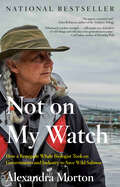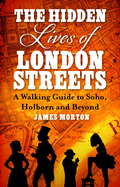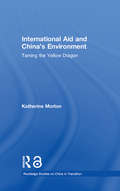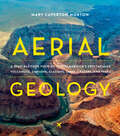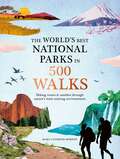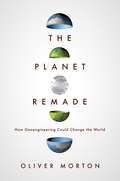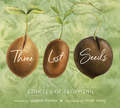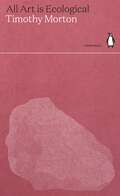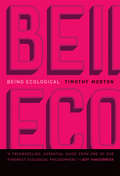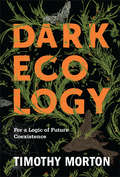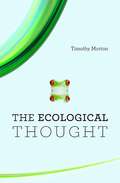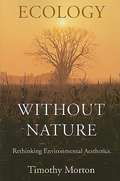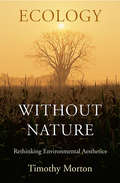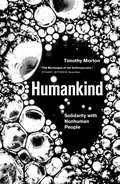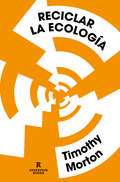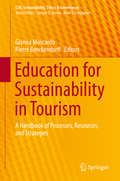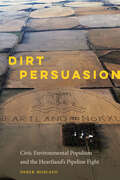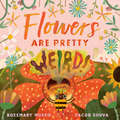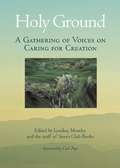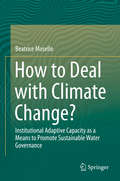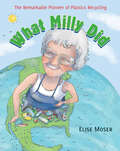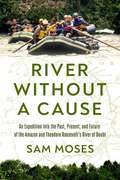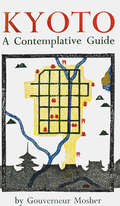- Table View
- List View
Not on My Watch: How a renegade whale biologist took on governments and industry to save wild salmon
by Alexandra MortonAlexandra Morton has been called "the Jane Goodall of Canada" because of her passionate thirty-year fight to save British Columbia's wild salmon. Her account of that fight is both inspiring in its own right and a roadmap of resistance.Alexandra Morton came north from California in the early 1980s, following her first love--the northern resident orca. In remote Echo Bay, in the Broughton Archipelago, she found the perfect place to settle into all she had ever dreamed of: a lifetime of observing and learning what these big-brained mammals are saying to each other. She was lucky enough to get there just in time to witness a place of true natural abundance, and learned how to thrive in the wilderness as a scientist and a single mother. Then, in 1989, industrial aquaculture moved into the region, chasing the whales away. Her fisherman neighbours asked her if she would write letters on their behalf to government explaining the damage the farms were doing to the fisheries, and one thing led to another. Soon Alex had shifted her scientific focus to documenting the infectious diseases and parasites that pour from the ocean farm pens of Atlantic salmon into the migration routes of wild Pacific salmon, and then to proving their disastrous impact on wild salmon and the entire ecosystem of the coast. Alex stood against the farms, first representing her community, then alone, and at last as part of an uprising that built around her as ancient Indigenous governance resisted a province and a country that wouldn't obey their own court rulings. She has used her science, many acts of protest and the legal system in her unrelenting efforts to save wild salmon and ultimately the whales--a story that reveals her own doggedness and bravery but also shines a bright light on the ways other humans doggedly resist the truth. Here, she brilliantly calls those humans to account for the sake of us all.
The Hidden Lives of London Streets: A Walking Guide to Soho, Holborn and Beyond
by James MortonLondon's streets have always worn a variety of influences, reflecting the diverse crowds who live and work on them. Take a walk down any number of historic streets and an abundance of tales exist in the bricks and mortar, waiting to be told. The Hidden Lives of London's Streets takes the reader on a journey through Soho, Piccadilly, Mayfair, Knightsbridge, Chelsea, Kensington, Fitzrovia and Clerkenwell. A street map is provided for each area, marking out the streets and buildings in which the various activities - some forgotten, others well-remembered - took place.Stories include those of courtesans such as the notorious Lola Montez and Theresa de Cornelys, who gave lavish balls at their home in Soho Square which were little more than orgies, during which a man playing the violin while on roller skates crashed through her plate glass window; Casanova and his quarrel with Marianne Charpillon after he taught a parrot to say she was a 'whore'; clubs - great (the Gargoyle), the artistic (Muriel Belcher's Colony), and the small (Royston Smith's club for dwarves); the police; robberies; murder and executions; the nightclubs; cinemas and theatres; the villains and prostitution. Beyond mere gangs and criminality, the book will trace the social changes that have gradually unfolded on any given street. For example the metamorphosis of Old Compton Street as home to race gangs in the 1920s, to becoming an essentially Italian street, to being part of the gay community.
International Aid and China's Environment: Taming the Yellow Dragon (Routledge Studies on China in Transition #Vol. 25)
by Katherine MortonRapid economic growth in the world's most populous nation is leading to widespread soil erosion, desertification, deforestation and the depletion of vital natural resources. The scale and severity of environmental problems in China now threaten the economic and social foundations of its modernization. Using case studies, Morton analyzes the relationship between international and local responses to environmental problems in China, challenging the prevailing wisdom that weak compliance is the only constraint upon local environmental management in China. It advances two interrelated discussions: first, it constructs a conceptual framework for understanding the key dimensions of environmental capacity. This is broadly defined to encompass the financial, institutional, technological and social aspects of environmental management. Second, the book presents the results of an empirical inquiry into the implementation of donor-funded environmental projects in both China's poorer and relatively developed regions. By drawing upon extensive fieldwork, it seeks to explain how, and under what conditions, international donors can strengthen China's environmental capacity, especially at the local level. It will be of interest to those studying Chinese politics, environmental studies and international relations.
Aerial Geology: A High-Altitude Tour of North America’s Spectacular Volcanoes, Canyons, Glaciers, Lakes, Craters, and Peaks
by Mary Caperton Morton“Get your head into the clouds with Aerial Geology.” —The New York Times Book ReviewAerial Geology is an up-in-the-sky exploration of North America’s 100 most spectacular geological formations. Crisscrossing the continent from the Aleutian Islands in Alaska to the Great Salt Lake in Utah and to the Chicxulub Crater in Mexico, Mary Caperton Morton brings you on a fantastic tour, sharing aerial and satellite photography, explanations on how each site was formed, and details on what makes each landform noteworthy. Maps and diagrams help illustrate the geological processes and clarify scientific concepts. Fact-filled, curious, and way more fun than the geology you remember from grade school, Aerial Geology is a must-have for the insatiably curious, armchair geologists, million-mile travelers, and anyone who has stared out the window of a plane and wondered what was below.
The World's Best National Parks in 500 Walks (500 Walks)
by Mary Caperton MortonAn inspiring and practical reference guide for hikers of all abilities who want to explore the world&’s national parks.Ever since Yellowstone National Park was established in 1872 as the world&’s first national park, the movement to preserve natural landscapes and habitats has spread to every continent. The World&’s Best National Parks in 500 Walks is the perfect inspiration for every explorer, from the armchair traveler to the veteran hiker, with full-color photos and vivid descriptions of some of the world&’s most spectacular hiking trails. Helpful tips on navigating the routes, planning your trips, and preparing for encounters with wildlife will have you lacing up your boots and strapping on your backpack, whether it&’s for a short weekday stroll or a multiday expedition on the world&’s most breathtaking trails.
The Planet Remade
by Oliver MortonThe risks of global warming are pressing and potentially vast. The difficulty of doing without fossil fuels is daunting, possibly even insurmountable. So there is an urgent need to rethink our responses to the crisis. To meet that need, a small but increasingly influential group of scientists is exploring proposals for planned human intervention in the climate system: a stratospheric veil against the sun, the cultivation of photosynthetic plankton, fleets of unmanned ships seeding the clouds. These are the technologies of geoengineering--and as Oliver Morton argues in this visionary book, it would be as irresponsible to ignore them as it would be foolish to see them as a simple solution to the problem. The Planet Remade explores the history, politics, and cutting-edge science of geoengineering. Morton weighs both the promise and perils of these controversial strategies and puts them in the broadest possible context. The past century's changes to the planet--to the clouds and the soils, to the winds and the seas, to the great cycles of nitrogen and carbon--have been far more profound than most of us realize. Appreciating those changes clarifies not just the scale of what needs to be done about global warming, but also our relationship to nature. Climate change is not just one of the twenty-first century's defining political challenges. Morton untangles the implications of our failure to meet the challenge of climate change and reintroduces the hope that we might. He addresses the deep fear that comes with seeing humans as a force of nature, and asks what it might mean--and what it might require of us--to try and use that force for good.
Three Lost Seeds: Stories Of Becoming (Tilbury House Nature Book #0)
by Stephie MortonTo author Stephie Morton, nature's powerful forces are a metaphor for the hardships faced by displaced children. Kids, like seeds, thrive when given a chance. Each of the three seeds in this story—a cherry seed in the Middle East, an acacia seed in Australia, and a lotus seed in Asia—survives a difficult journey through flood, fire, or drought, then sprouts (in the case of the lotus seed, a hundred years later) and flourishes. Stephie's verses and Nicole Wong's art make a picture book to treasure.
All Art is Ecological (Green Ideas)
by Timothy MortonIn twenty short books, Penguin brings you the classics of the environmental movement.Provocative and playful, All Art is Ecological explores the strangeness of living in an age of mass extinction, and shows us that emotions and experience are the basis for a deep philosophical engagement with ecology.Over the past 75 years, a new canon has emerged. As life on Earth has become irrevocably altered by humans, visionary thinkers around the world have raised their voices to defend the planet, and affirm our place at the heart of its restoration. Their words have endured through the decades, becoming the classics of a movement. Together, these books show the richness of environmental thought, and point the way to a fairer, saner, greener world.
Being Ecological (The\mit Press Ser.)
by Timothy MortonA book about ecology without information dumping, guilt inducing, or preaching to the choir.Don't care about ecology? You think you don't, but you might all the same. Don't read ecology books? This book is for you. Ecology books can be confusing information dumps that are out of date by the time they hit you. Slapping you upside the head to make you feel bad. Grabbing you by the lapels while yelling disturbing facts. Handwringing in agony about “What are we going to do?” This book has none of that. Being Ecological doesn't preach to the eco-choir. It's for you—even, Timothy Morton explains, if you're not in the choir, even if you have no idea what choirs are. You might already be ecological.After establishing the approach of the book (no facts allowed!), Morton draws on Kant and Heidegger to help us understand living in an age of mass extinction caused by global warming. He considers the object of ecological awareness and ecological thinking: the biosphere and its interconnections. He discusses what sorts of actions count as ecological—starting a revolution? going to the garden center to smell the plants? And finally, in “Not a Grand Tour of Ecological Thought,” he explores a variety of current styles of being ecological—a range of overlapping orientations rather than preformatted self-labeling. Caught up in the us-versus-them (or you-versus-everything else) urgency of ecological crisis, Morton suggests, it's easy to forget that you are a symbiotic being entangled with other symbiotic beings. Isn't that being ecological?
Dark Ecology: For a Logic of Future Coexistence (The Wellek Library Lectures)
by Timothy MortonTimothy Morton argues that ecological awareness in the present Anthropocene era takes the form of a strange loop or Möbius strip, twisted to have only one side. Deckard travels this oedipal path in Blade Runner (1982) when he learns that he might be the enemy he has been ordered to pursue. Ecological awareness takes this shape because ecological phenomena have a loop form that is also fundamental to the structure of how things are.The logistics of agricultural society resulted in global warming and hardwired dangerous ideas about life-forms into the human mind. Dark ecology puts us in an uncanny position of radical self-knowledge, illuminating our place in the biosphere and our belonging to a species in a sense that is far less obvious than we like to think. Morton explores the logical foundations of the ecological crisis, which is suffused with the melancholy and negativity of coexistence yet evolving, as we explore its loop form, into something playful, anarchic, and comedic. His work is a skilled fusion of humanities and scientific scholarship, incorporating the theories and findings of philosophy, anthropology, literature, ecology, biology, and physics. Morton hopes to reestablish our ties to nonhuman beings and to help us rediscover the playfulness and joy that can brighten the dark, strange loop we traverse.
The Ecological Thought
by Timothy MortonIn this passionate, lucid, and surprising book, Timothy Morton argues that all forms of life are connected in a vast, entangling mesh. This interconnectedness penetrates all dimensions of life. No being, construct, or object can exist independently from the ecological entanglement, Morton contends, nor does “Nature” exist as an entity separate from the uglier or more synthetic elements of life. Realizing this interconnectedness is what Morton calls the ecological thought.<P> In three concise chapters, Morton investigates the profound philosophical, political, and aesthetic implications of the fact that all life forms are interconnected. As a work of environmental philosophy and theory, The Ecological Thought explores an emerging awareness of ecological reality in an age of global warming. Using Darwin and contemporary discoveries in life sciences as root texts, Morton describes a mesh of deeply interconnected life forms—intimate, strange, and lacking fixed identity.<P> A “prequel” to his Ecology without Nature: Rethinking Environmental Aesthetics (Harvard, 2007), The Ecological Thought is an engaged and accessible work that will challenge the thinking of readers in disciplines ranging from critical theory to Romanticism to cultural geography.
Ecology Without Nature: Rethinking Environmental Aesthetics
by Timothy MortonIn Ecology without Nature, Timothy Morton argues that the chief stumbling block to environmental thinking is the image of nature itself. Ecological writers propose a new worldview, but their very zeal to preserve the natural world leads them away from the "nature" they revere. The problem is a symptom of the ecological catastrophe in which we are living. Morton sets out a seeming paradox: to have a properly ecological view, we must relinquish the idea of nature once and for all. Ecology without Nature investigates our ecological assumptions in a way that is provocative and deeply engaging. Ranging widely in eighteenth-century through contemporary philosophy, culture, and history, he explores the value of art in imagining environmental projects for the future. Morton develops a fresh vocabulary for reading "environmentality" in artistic form as well as content, and traces the contexts of ecological constructs through the history of capitalism. From John Clare to John Cage, from Kierkegaard to Kristeva, from The Lord of the Rings to electronic life forms, Ecology without Nature widens our view of ecological criticism, and deepens our understanding of ecology itself. Instead of trying to use an idea of nature to heal what society has damaged, Morton sets out a radical new form of ecological criticism: "dark ecology. "
Ecology without Nature: Rethinking Environmental Aesthetics
by Timothy MortonIn Ecology without Nature, Timothy Morton argues that the chief stumbling block to environmental thinking is the image of nature itself. Ecological writers propose a new worldview, but their very zeal to preserve the natural world leads them away from the "nature" they revere. The problem is a symptom of the ecological catastrophe in which we are living. Morton sets out a seeming paradox: to have a properly ecological view, we must relinquish the idea of nature once and for all. Ecology without Nature investigates our ecological assumptions in a way that is provocative and deeply engaging. Ranging widely in eighteenth-century through contemporary philosophy, culture, and history, he explores the value of art in imagining environmental projects for the future. Morton develops a fresh vocabulary for reading "environmentality" in artistic form as well as content, and traces the contexts of ecological constructs through the history of capitalism. From John Clare to John Cage, from Kierkegaard to Kristeva, from The Lord of the Rings to electronic life forms, Ecology without Nature widens our view of ecological criticism, and deepens our understanding of ecology itself. Instead of trying to use an idea of nature to heal what society has damaged, Morton sets out a radical new form of ecological criticism: "dark ecology."
Humankind: Solidarity with Non-Human People
by Timothy MortonA radical call for solidarity between humans and non-humansWhat is it that makes humans human? As science and technology challenge the boundaries between life and non-life, between organic and inorganic, this ancient question is more timely than ever. Acclaimed Object-Oriented philosopher Timothy Morton invites us to consider this philosophical issue as eminently political. It is in our relationship with non-humans that we decided the fate of our humanity. Becoming human, claims Morton, actually means creating a network of kindness and solidarity with non-human beings, in the name of a broader understanding of reality that both includes and overcomes the notion of species. Negotiating the politics of humanity is the first and crucial step to reclaim the upper scales of ecological coexistence, not to let Monsanto and cryogenically suspended billionaires to define them and own them.From the Trade Paperback edition.
Reciclar la ecología: Pensar el mundo tras el fin de la naturaleza
by Timothy MortonPor fin un libro sobre ecología que no es un vertedero de información, ni un billete hacia el sentimiento de culpa, ni un sermón a la masa aborregada. ¿No te importa la ecología? Eso es lo que crees. ¿No lees libros de ecología? Este libro es para ti. Este ensayo tiene la intención de darle la vuelta a la ecología y enseñarnos a pensar en ella cuando la naturaleza ha desaparecido. De nada sirve ya la manera actual de entenderla, repleta de pseudodatos que confunden e instalada en el «¿qué será de nosotros?». En el corazón de este ambicioso ensayo hay una crítica radical a la distancia científica con que reflexionamos sobre nuestro entorno: el mundo solo puede ser captado si lo experimentamos. Lo que nos abruma no es el fin de la naturaleza sino los prejuicios sobre el lugar que deberían ocupar los humanos en el mundo. Morton lanza un torpedo a la línea de flotación de la arrogancia antropocentrista mediante analogías memorables entre Kant y Star Wars, Blade Runner, letras de los Talking Heads o el budismo tibetano. No se trata de construir una sociedad más amable con el medioambiente, se trata de cambiar el paradigma de nuestra relación con el mundo. La crítica ha dicho...«Leo desde hace años los libros de Tim y debo decir que me encantan.»Björk «Un ecologista que se preocupa de asuntos estructurales en vez de regañarte por no separar el plástico de la basura orgánica.»Ernesto Castro «Leer a Morton es quedar atrapado en un brillante despliegue de pirotecnia intelectual.»The Guardian «Morton hace un esfuerzo notable para extender el género filosófico hasta territorios apetecibles para una amplia variedad de lectores. En vez de intentar; de manera angustiante; someter a validación todas las estrategias infructuosas del activismo o de las políticas medioambientales (que él considera un esfuerzo fútil en un mundo tan cambiante como el nuestro); Morton nos abre la puerta; casi nos da permiso; para abrazar lo incierto.»Massive «Una guía imprescindible y muy alternativa para vivir ecológicamente; por uno de nuestros filósofos más eminentes. Muy útil para todo aquel que quiera entender mejor cuál es nuestra relación con la biosfera. Lo que propone Morton es saber vivir una vida con sentido en una era incierta; la nuestra.»Jeff VanderMeer «Si aún piensas que la naturaleza mola y es guay; piensa otra vez. La ontología plana de Timothy Morton [...] desmonta muchos clichés adquiridos y abre nuevas posibilidades para concebir un futuro mejor juntos. Reciclar la ecología lo logra; además; promoviendo la discusión en un tono estimulante y muy libresco.»Nick Montfort; catedrático de Digital Media del MIT y autor de The Future
Education for Sustainability in Tourism
by Gianna Moscardo Pierre BenckendorffSustainability is a dominant theme in tourism practice. Increasingly, research and education of tourism stakeholders is also necessary in improving sustainable tourism practice. This book pays systematic attention to education for sustainability in tourism, and is thus a valuable resource for sustainable tourism educators and scholars. The book is divided into four parts. Part I provides a reference for educators seeking to understand core knowledge areas, ethics, corporate social responsibility and governance. Part II examines issues and processes relevant to understanding tourism and sustainability in the formal educational sector, including universities, vocational training and school settings. Part III explores learning and sustainable tourism in non-institutional settings, including destination communities, coaching and mentoring and visitor learning. The final part provides a collection of cases to illustrate the use of different pedagogies and assessment approaches in education for sustainability in tourism. The book will be accompanied by instructor resources to assist educators teaching in the field.
Dirt Persuasion: Civic Environmental Populism and the Heartland's Pipeline Fight
by Derek MoscatoDirt Persuasion examines a watershed moment in U.S. environmental politics: the fight over the Keystone XL Pipeline. The complex interplay of resources extraction industries with grassroots environmentalism and advocacy has transformed the role of activists in the contemporary public sphere. Bold Nebraska&’s years-long fight against pipeline company TransCanada provides a compelling case study: a contemporary state-level organization that simultaneously challenged political and business leaders in its home state of Nebraska, at the national level in the United States, and in the foreign jurisdiction of Canada.Dirt Persuasion sheds light not only on the activism practices of social movements but also on the changing environments in which such actions are deployed. The KXL Pipeline fight represents a watershed moment both for U.S. energy politics and in the communication of environmental activism. The rural dimension of this environmental saga is critical: environmentalism must be understood from the perspective of the rural Americans who coexist with one of the planet&’s most delicate ecologies. Populism, rhetorical appeals, strategic advocacy framing, and media framing all factor prominently within the pipeline debate—leading to a civic environmental persuasion built on the attributes of narrative, engagement, hyperlocalization, and bipartisanship in order to build broad stakeholder support and influence public policy.
Flowers Are Pretty ... Weird! (Nature's Top Secrets)
by Rosemary MoscoWarning -- this book contains top-secret information about flowers! Prepare to be shocked and weirded out by this hilarious and totally true picture book introduction to some of nature's strangest plants.Flowers are beautiful. They have bright colors, soft petals and sweet nectar. Yum! But that's not the whole truth. Flowers can be WEIRD . . . and one bee is here to let everyone know! Talking directly to the reader, a bee reveals how flowers are so much stranger than what we think. Did you know that there are some flowers that only bloom in the nighttime? Some flowers are spooky, and look like ghosts, or bats, or a monster's mouth. And while most flowers smell good, there are some that smell like dead meat, or even horse poop! This hilarious and refreshing book with silly and sweet illustrations explores the science of flowers and shows that these plants are not always stereotypically pretty and harmless as we often think they are -- they are fascinating, disgusting, complicated and amazing.
Holy Ground: A Gathering of Voices on Caring for Creation
by Lyndsay MoseleyReligions worldwide celebrate Earth's abundance and sustenance, and call on humankind to give thanks, practice compassion, seek justice, and be mindful of future generations. Here, leaders from many faith traditions, along with writers who hold nature sacred, articulate the moral and spiritual imperative of stewardship and share personal stories of coming to understand humans' unique power and responsibility to care for creation. Holy Ground features essays, sermons, and other short pieces from, among others, Pope Benedict XVI, Orthodox Patriarch Bartholomew I, Islamic scholar Seyyed Hossein Nasr, Rabbis Zoe Klein and Arthur Waskow, Evangelical pastors Joel Hunter and Brian McLaren, environmental justice proponents Allen Johnson and Kristin Shrader-Frechette, Native American novelist Linda Hogan, and writers Wendell Berry, Gary Snyder, Terry Tempest Williams, and David James Duncan. In a world polarized by "culture wars," religious extremism, and political manipulation, this collection is a sure sign of hope.
How to Deal with Climate Change?
by Beatrice MoselloAs the evidence for human-induced climate change becomes more obvious, so too does the realisation that it will harshly impact on the natural environment as well as on socio-economic systems. Addressing the unpredictability of multiple sources of global change makes the capacity of governance systems to deal with uncertainty and surprise essential. However, how all these complex processes act in concert and under which conditions they lead to the sustainable governance of environmental resources are questions that have remained relatively unanswered. This book aims at addressing this fundamental gap, using as case examples the basins of the Po River in Northern Italy and the Syr Darya River in Kyrgyzstan. The opening chapter addresses the challenges of governing water in times of climate and other changes. Chapter Two reviews water governance through history and science. The third chapter outlines a conceptual framework for studying institutional adaptive capacity. The next two chapters offer detailed case studies of the Po and Syr Darya rivers, followed by a chapter-length analysis and comparison of adaptive water resources management in the two regions. The discussion includes a description of resistant, reactive and proactive institutions and puts forward ideas on how water governance regimes can transition from resistant to proactive. The final chapter takes a high-level view of lessons learned and how to transform these into policy recommendations and offers a perspective on embracing uncertainty and meeting future challenges.
Embrace Your Inner Wild
by Don Moseman Mary Reynolds ThompsonEmbrace Your Inner Wild: 52 Reflections for an Eco-Centric World is a brilliant, full-color book of photographs and reflections that invite you to seek out wildness wherever you find it - within or without.Don Moseman's spectacular photographs feature the wildlife and terrain of Marin County, California: the fiercely intelligent eyes of the coyote, the spiraling hawk in the supine sky, a bobcat prowling through golden grasses. These photos are paired with reflections by Mary Reynolds Thompson to awaken the reader to wonder. And to oneness.Don spent twenty-five years in San Quentin maximum-security prison in Marin County, California. In 1989, got sober and went straight, encouraged by nature as a guide. Later, taking up photography, the patience he learned in prison paid off. Don knows how to wait for the wild to come to him. Since 1983, the natural world has been key to Mary's successful recovery from alcoholism. A life coach and facilitator of poetry therapy, Mary has developed a unique program of ecological spirituality that connects clients to their true selves through nature.Embrace Your Inner Wild is a visual and verbal psalm to wildness, rooted in Don and Mary's shared love of the earth, its inhabitants, and the wild soul that longs to be set free.
What Milly Did: The Remarkable Pioneer of Plastics Recycling
by Elise MoserThe extraordinary story of the woman who made plastics recycling possible. Milly Zantow wanted to solve the problem of her town’s full landfill and ended up creating a global recycling standard — the system of numbers you see inside the little triangle on plastics. This is the inspiring story of how she mobilized her community, creating sweeping change to help the environment. On a trip to Japan in 1978, Milly noticed that people were putting little bundles out on the street each morning. They were recycling — something that hadn’t taken hold in North America. When she returned to Sauk City, Wisconsin, she discovered that her town’s landfill was nearing capacity, and that plastic made up a large part of the garbage. No one was recycling plastics. Milly decided to figure out how. She discovered that there are more than seven kinds of plastic, and they can’t be combined for recycling, so she learned how to use various tests to identify them. Then she found a company willing to use recycled plastic, but the plastic would have to be ground up first. Milly and her friend bought a huge industrial grinder and established E-Z Recycling. They worked with local school children and their community, and they helped other communities start their own recycling programs. But Milly knew that the large-scale recycling of plastics would never work unless people could easily identify the seven types. She came up with the idea of placing an identifying number in the little recycling triangle, which has become the international standard. Milly's story is a glimpse into the early days of the recycling movement and shows how, thanks to her determination, hard work and community-building, huge changes took place, spreading rapidly across North America. Correlates to the Common Core State Standards in English Language Arts: CCSS.ELA-LITERACY.RI.3.3 Describe the relationship between a series of historical events, scientific ideas or concepts, or steps in technical procedures in a text, using language that pertains to time, sequence, and cause/effect. CCSS.ELA-LITERACY.RI.4.7 Interpret information presented visually, orally, or quantitatively (e.g., in charts, graphs, diagrams, time lines, animations, or interactive elements on Web pages) and explain how the information contributes to an understanding of the text in which it appears.
River Without a Cause: An Expedition through the Past, Present and Future of Theodore Roosevelt's River of Doubt
by Sam MosesA riveting journey down Theodore Roosevelt's "river of doubt" with a diverse crew of adventurers, scientists, and Indigenous leaders who shine light on the past, present, and future of a natural wonder.Sam Moses took part in the adventure of a lifetime when he, along with seventeen men and two women, embarked on the Rio Roosevelt Expedition. They would follow the former president's wake down five-hundred miles of extreme whitewater into the dark heart of the Amazon. The party was guided by two chiefs from the Cinta Larga tribe—the same tribe that stalked Roosevelt&’s expedition in 1914—who, between rapids, tell the story of the tribe&’s own Trail of Tears. After the wildest whitewater is past, Moses travels with the chiefs to their village to witness the massive illegal mahogany logging from their forest, the Roosevelt Indigenous Territory. River Without a Cause puts us in the raft during those heart pounding rapid descents, as we experience the drama, dynamics and disputes between the Bull Moose and his co-leader, Brazil&’s most famous explorer, the rigid Colonel Candido Rondon. As the Amazon stands on the precipiece of hope with the election of a new Brazillian president, River Without a Cause is a moving and galvanzing tale of adventure that is a fitting tribute to this world wonder.
Kyoto: A Contemplative Guide
by Gouverneur MosherThis Kyoto travel guide presents the best tourists sites in Japan's spiritual and historical capital.With this guide the visitor needs no further assistance to learn all that a place has to offer. It is factual, concise, and complete. This Japan travel book is generously illustrated with photographs, maps, route plans, and building plans, as well as a selection of reproductions from old prints and picture scrolls.The sights were specifically chosen to give foreign visitors a broad understanding of Kyoto's political, religious, and cultural history. Among them are the ancient Phoenix Hall of the Byodo-in, the famous rock garden at Ryoan-ji, the mountain temples of Enryaku-ji, the lavishly decorated Nijo Castle of the Tokugawas, the Silver Pavilion and its remarkable garden, and the "all-time temple," Kiyomizu.Three appendices--a chart of Japanese art periods, a glossary and a list of useful Japanese phrases--further enhance its value.
Day of the Blizzard
by Marietta D. Moskin Stephen GammellA brave little girl named Katie goes through a lot of trouble to get her mama's brooch back from the pawn shop.
